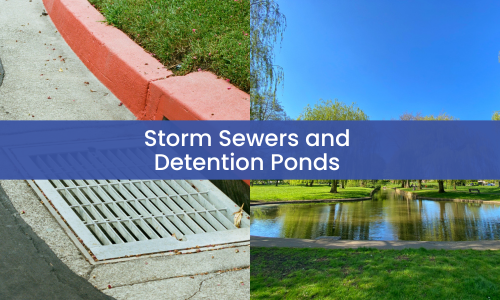Storm Sewers and Detention Ponds are Critical for Controlling Stormwater
Adequate drainage is something every property requires. Without it, the soil will retain excess water, develop stability issues, and attract pests. Inefficient drainage is often the first sign of future foundation damage, so standing water on your property isn’t as harmless as it looks.
In developed areas, managing storm runoff can be tricky. With less vegetation to retain flowing water, well-planned and well-built drainage structures are a must. This includes structures like storm sewers, detention ponds and culverts. These structures are typically formed from concrete, so concrete construction teams are the go-to experts for drainage construction and maintenance.
The Role Storm Sewers and Detention Ponds Play in Stormwater Management
Storm sewers and detention ponds each play a vital role in channeling runoff and promoting adequate runoff flow through the property. Here’s a closer look at how each structure plays their part:
- Storm sewers – Every municipality has a network of storm sewers, and this tangle of drains and pipes is responsible for capturing rainwater and carrying it to natural sources like streams, rivers, and lakes. Storm sewers are connected to the drains you’ll see lining the curb. Once rainwater is captured by one of these drains into a catch basin, it flows into the sewer pipes themselves.
These pipes run for miles and pass through a series of other concrete structures – most of them culverts – before they reach the end of the route. When developing a commercial property, it’s essential that it be outfitted with drains that connect to the city’s storm sewers.
- Detention ponds – Detention ponds (also called detention basins) are large depressions shaped out of the land and used to capture high volumes of runoff. They are effective at preventing surface flooding on a property, and they can provide an aesthetic boost as well.
Detention ponds may be too big to implement on some properties, which is why you’ll often see them developed for entire communities or for major commercial properties.
Detention ponds capture rainwater as it flows down using a gentle slope. At the bottom of the pond, an inlet takes the water in and channels it into storm sewers. In the majority of cases a detention pond dries out between storms.
What’s the Difference Between Storm Sewers and Sanitary Sewers?
Not all sewers are the same. Storm sewers collect rainwater and empty out into natural sources. This water is not treated along the way and is carried directly from the storm sewer to the capturing natural source.
Sanitary sewers resemble storm sewers in construction, but instead of capturing runoff, sanitary sewers take in wastewater from toilets, sinks, and other contaminated sources. This water is carried separately from storm water and is diverted through water treatment facilities for decontamination before being diverted into natural sources.
What’s the Difference Between Detention Ponds and Retention Ponds?
Detention ponds and retention ponds are extremely similar in their role – both are designed to capture and contain rainwater so property flooding does not occur. The difference is detention ponds fill and empty between rain events. Retention ponds, like their name suggests, retain a certain water depth even when there are extended stretches between rain events. As such, retention ponds can be value-boosting property additions for their appearance, but insect control can be a concern with them.
Storm Sewers and Detention Ponds are Complex Projects and Require Engineering Expertise
Most construction projects require engineering insight and analysis to accomplish safely, and that includes drainage structures. When installing new drainage, the construction and engineering team must consider the following:
- Expectations for future rainfall and the system’s maximum capacity
- The desired throughput and flow rate through the system
- The soil’s composition and stability around the drainage structure
- The slope and shape of the property
- The presence of vegetation around the drainage structure
- The presence of other structures and paved surfaces on the property
- Whether the drainage structure will be subjected to vehicle loading
- The presence of pedestrians on the property
- The scope and cost of the project
In short, every drainage project is a balance between performance and cost. Bigger pipes and ponds can always be installed to boost drainage efficiency, but this may not be cost efficient enough to remain in budget. An experienced engineer can take those cost considerations into account when optimizing a new drainage system.
Storm Sewers, Detention Ponds and Other Drainage Structures are Essential for Property Maintenance
It’s easy to ignore a little standing water, but that’s a clear sign that the property’s drainage infrastructure needs an inspection. As water backs up onto the property, it causes a multitude of problems. It damages the property’s appearance and the impression it makes. It soaks the soil and causes it to shift, which is a nightmare for foundations. Standing water can also draw in pests and pathogens, and it can produce safety hazards for motorists and pedestrians.
There are plenty of reasons to maintain an effective drainage system, but there are also plenty of challenges involved. Those challenges can only be properly met with engineer experience, so your chosen Houston concrete construction team should also include experienced engineers. This will ensure your drainage system keeps your property dry, stable, and looking its best.
- HOA & Condos – How Asphalt Pavement Can Affect Your Houston Property Values - March 6, 2025
- What Certifications or Licenses Should a Houston Asphalt Contractor Have? - September 17, 2024
- Common Challenges in Concrete Construction - September 11, 2024

